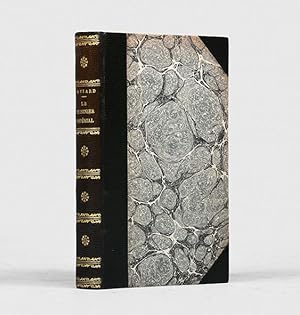viard alexandre andré (1 résultats)
Type d'article
- Tous les types d'articles
- Livres (1)
- Magazines & Périodiques
- Bandes dessinées
- Partitions de musique
- Art, Affiches et Gravures
- Photographies
- Cartes
-
Manuscrits &
Papiers anciens
Etat
- Tous
- Neuf
- Ancien ou d'occasion
Reliure
- Toutes
- Couverture rigide
- Couverture souple
Particularités
- Edition originale
- Signé
- Jaquette
- Avec images
- Sans impression à la demande
Pays
Evaluation du vendeur
-
Le cuisinier impérial, ou l'art de faire la cuisine et la patisserie pour toutes les fortunes; avec différentes Recettes d'Office et de Fruts confits, et la manière de servir une Table depuis vingt jusqu'à soixante Couverts.
Edité par Paris: Barba, 1806, 1806
Vendeur : Peter Harrington. ABA/ ILAB., London, Royaume-Uni
Edition originale
Scarce first edition of this essential culinary encyclopaedia, the most popular work published by a professional cook in the 19th century. Viard, a worthy competitor to Carême in terms of celebrity, dedicated his book to the famed gourmand and restaurant reviewer Grimod de La Reynière, praising Grimod and his fellow food enthusiasts for having elevated culinary discourse. "To judge from his practical knowledge, Viard must have been a professional cook at one time [thought to have been chef de cuisine to Louis Philippe, comte de Ségur and Francis Egerton, 8th Earl of Bridgewater], but he described himself simply as an homme de bouche (food expert), probably someone in charge of catering for a large household. Despite his book's impressive title, Viard declared he was writing for 'all levels of fortune' in this egalitarian society of citoyens, and indeed the polished text includes such basics as pea soup, quick-cooked rabbit, and salt cod provençale. At a higher level, he was the first cook to describe the classic, puffy soufflé, flavoured with chestnuts, frangipane, white coffee, vanilla, or potato (still a novelty), that became such a symbol of France. The book did well, even when the restoration of the French monarchy required a hasty title change to Le cuisinier royale and the 'year of revolutions' in 1848 precipitated another change, this time to Le cuisinier national. only to revert to impérial once more under Emperor Napoleon III. The text, too, underwent hundreds of additions, first by Viard and later by colleagues, allowing it to remain in print until 1875" (Willan), running to at least thirty-two editions. Food scholar Darra Goldstein notes that Le cuisinier impérial also contains the first published recipe for apple charlotte. Hector Dubois d'Enghien was a trade bookbinder, son of the prominent Brussels binder Joseph-François Dubois d'Enghien (1841-1923). He took over his father's workshop c.1918 and partnered with Edmond Dooms, a gilder from De Samblanx, in 1923. An accomplished scholar, Hector Dubois d'Enghien wrote a history of bookbinding in Belgium, published in 1954. The first edition of Le cuisinier impérial is rare both institutionally and commercially. WorldCat, Library Hub, and KVK locate just six copies institutionally: three copies in Germany (Badische LB, LB Rheinland-Pfalz, Sächsische LB), two in the US (Harvard Schlesinger, Indiana), and one in France (BnF). We can trace four copies at auction since the 1920s, only one of which is dated from within the last 45 years. Cagle 433; Vicaire 860; Willan, pp. 258-9. Not in Bitting, see note on p. 478 for later editions. Darra Goldstein, The Oxford Companion to Sugar and Sweets, 2015. Octavo (192 x 122 mm). Beautifully bound by Dubois d'Enghien-Dooms in early 20th-century dark green straight-grain half morocco, smooth spine lettered in gilt, separated into compartments with gilt scrollwork rolls and double fillets, floral motifs to first, third, fourth, and fifth compartments, marbled boards, edges sprinkled blue. Bound, like Cagle, without the first leaf (half-title, verso a publisher's advertisement). Fine externally; binder's stamp to front pastedown, contents evenly browned and generally clean, central gatherings foxed and single stain to sig. 7.7, small spot to p. 387 partly obscuring one word, a few ink marks to Index. An excellent copy.


